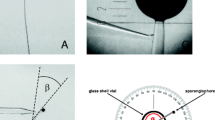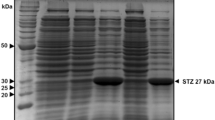Abstract
The biosynthesis of ethylene was examined in suspension-cultured cells of parsley (Petroselinum hortense) treated with an elicitor from cell walls of Phytophthora megasperma. Untreated cells contained 50 nmol g-1 of the ethylene precursor, 1-aminocyclopropane-1-carboxylic acid (ACC), and produced ethylene at a rate of about 0.5 nmol g-1 h-1. Within 2 h after addition of elicitor to the culture medium, the cells started to produce more ethylene and accumulated more ACC. Exogenously added ACC did not increase the rate of ethylene production in control or elicitor-treated cells, indicating that the enzyme converting ACC to ethylene was limiting in both cases. The first enzyme in ethylene biosynthesis, ACC synthase, was very rapidly and transiently induced by the elicitor treatment. Its activity increased more than tenfold within 60 min. Density labelling with 2H2O showed that this increase was caused by the denovo synthesis of the enzyme protein. Cordycepin and actinomycin D did not affect the induction of ACC synthase, indicating that the synthesis of new mRNA was not required. The peak of ACC-synthase activity preceded the maximal phenylalanine ammonia-lyase (PAL) activity by several hours. Exogenously supplied ethylene or ACC did not induce PAL. However, aminoethoxyvinylglycine, an inhibitor of ACC synthase, suppressed the rise in ethylene production in elicitor-treated cells and partially inhibited the induction of PAL. Exogenously supplied ACC reversed this inhibition. It is concluded that induction of the ethylene biosynthetic pathway is a very early symptom of elicitor action. Although ethylene alone is not a sufficient signal for PAL induction, the enhanced activity of ACC synthase and the ethylene biosynthetic pathway may be important for the subsequent induction of PAL.
Similar content being viewed by others
Abbreviations
- ACC:
-
1-aminocyclopropane-1-carboxylic acid
- AVG:
-
aminoethoxyvinylglycine
- PAL:
-
phenylalanine ammonia-lyase
References
Acaster, M.A., Kende, H. (1983) Properties and partial purification of 1-aminocyclopropane-1-carboxylate synthase. Plant Physiol. 72, 139–145
Ayers, A.R., Ebel, J., Finelli, F., Berger, N., Albersheim, P. (1976) Host-pathogen interactions. IX. Quantitative assays of elicitor activity and characterization of the elicitor present in the extracellular medium of cultures of Phytophthora megasperma var. sojae. Plant Physiol. 57, 751–759
Boller, T. (1982) Ethylene-induced biochemical defenses against pathogens. In: Plant growth substances 1982, pp. 303–312, Wareing, P.F., ed. Academic Press, London
Boller, T., Kende, H., (1980) Regulation of wound ethylene synthesis in plants. Nature (London) 286, 259–260
Boller, T., Gehri, A., Mauch, F., Vögeli, U. (1983) Chitinase in bean leaves: induction by ethylene, purification, properties, and possible function. Planta 157, 22–31
Bradford, M.M. (1976) A rapid and sensitive method for the quantitation of microgram quantities of protein utilizing the principle of protein-dye binding. Anal. Biochem. 72, 248–254
Chalutz, E. (1973) Ethylene-induced phenylalanine ammonialyase activity in carrot roots. Plant Physiol. 51, 1033–1036
Chalutz, E., DeVay, J.E., Maxie, E.C. (1969) Ethylene-induced isocoumarin formation in carrot root tissue. Plant Physiol. 44, 235–241
De Laat, A.M.M., Van Loon, L.C. (1982) Regulation of ethylene biosynthesis in virus-infected tobacco leaves. II. Time course of levels of intermediates and in vivo conversion rates. Plant Physiol. 69, 240–245
Dixon, R.A., Lamb, C.J. (1979) Stimulation of de novo synthesis of l-phenylalanine ammonia-lyase in relation to phytoalexin accumulation in Colletotrichum lindemuthianum elicitor-treated cell suspension cultures of french bean (Phaseolus vulgaris) Biochim. Biophys. Acta 586, 453–463
Fuhrer, J. (1982) Ethylene biosynthesis and cadmium toxicity in leaf tissue of beans (Phaseolus vulgaris L.). Plant Physiol. 70, 162–167
Hahlbrock, K., Ragg, H. (1975) Light-induced changes of enzyme activities in parsley cell suspension cultures. Arch. Biochem. Biophys. 166, 41–46
Hahlbrock, K., Lamb, C.J., Purwin, C., Ebel, J., Fautz, E., Schäfer, E. (1981) Rapid response of suspension-cultured parsley cells to the elicitor from Phytophthora megasperma var. sojae. Plant Physiol. 67, 768–773
Hoffman, N.E., Yang, S.F. (1982) Enhancement of wound-induced ethylene synthesis by ethylene in preclimacteric cantaloupe. Plant Physiol. 69, 317–322
Hyodo, Y., Yang, S.F. (1971) Ethylene-induced synthesis of phenylalanine ammonia-lyase in pea seedlings. Plant Physiol. 47, 765–770
Hyodo, H., Kuroda, H., Yang, S.F. (1978) Induction of phenylalanine ammonia-lyase and increase in phenolics in lettuce leaves in relation to the development of russet spotting caused by ethylene. Plant Physiol. 62, 31–35
Kuhn, D.N., Chappell, J., Hahlbrock, K. (1984) Induction of phenylalanine ammonia-lyase and 4-coumarate: CoA ligase mRNAs in cultured plant cells by UV light or fungal elicitor. Proc. Natl. Acad. Sci. USA (in press)
Lizada, C., Yang, S.F. (1979) A simple and sensitive assay for 1-aminocyclopropane-1-carboxylic acid. Anal. Biochem. 100, 140–145
Paradies, I., Konze, J.R., Elstner, E.F., Paxton, J. (1980) Ethylene: indicator but not inducer of phytoalexin synthesis in soybean. Plant Physiol. 66, 1106–1109
Ragg, H., Kuhn, D.N., Hahlbrock, K. (1981) Coordinated regulation of 4-coumarate: CoA ligase and phenylalanine ammonia-lyase mRNAs in cultured plant cells. J. Biol. Chem. 256, 10061–10065
Riov, J., Monselise, S.P., Kahan, R.S. (1969) Ethylene-controlled induction of phenylalanine ammonia-lyase in citrus fruit peel. Plant Physiol. 44, 631–635
Tietjen, K.G., Hunkler, D., Matern, U. (1983) Differential response of cultured parsley cells to elicitors from two nonpathogenic strains of fungi. Identification of induced products as coumarin derivatives. Eur. J. Biochem. 131, 401–407
Yang, S.F., Pratt, H.K. (1978) The physiology of ethylene in wounded plant tissues. In: Biochemistry of wounded plant tissues, pp. 595–622, Kahl, G., ed. de Gruyter, Berlin New York
Yu, Y.B., Yang, S.F. (1980) Biosynthesis of wound ethylene. Plant Physiol. 66, 281–285
Author information
Authors and Affiliations
Rights and permissions
About this article
Cite this article
Chappell, J., Hahlbrock, K. & Boller, T. Rapid induction of ethylene biosynthesis in cultured parsley cells by fungal elicitor and its relationship to the induction of phenylalanine ammonia-lyase. Planta 161, 475–480 (1984). https://doi.org/10.1007/BF00394581
Received:
Accepted:
Issue Date:
DOI: https://doi.org/10.1007/BF00394581




